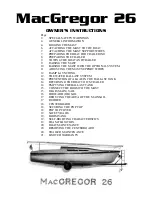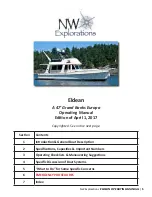
BOATING SAFETY
1-13
CRUISING LIMITATIONS
•
Scan constantly for people, objects, and other watercraft. Be alert for conditions that limit your visibility or
block your vision of others.
•
Operate defensively at safe speeds and keep a safe distance from people, objects, and other watercraft.
•
Do not follow directly behind other boats.
•
Do not go near others to spray or splash them with water.
•
Avoid sharp turns or other maneuvers that make it hard for others to avoid you or understand where you are
going.
•
Avoid areas with submerged objects or shallow water.
•
Operate within your limits and avoid aggressive maneuvers to reduce the risk of loss of control, ejection, and
collision.
•
This is a high-performance boat – not a toy. Sharp turns or jumping waves or wakes can increase the risk of
back/spinal injury (paralysis), facial injuries, and broken legs, ankles, and other bones. Do not jump waves or
wakes.
•
Do not operate the boat in rough water, bad weather, or when visibility is poor; this may lead to an accident
causing injury or death. Be alert to the possibility of bad weather. Take note of weather forecasts and the
prevailing weather conditions before setting out in your boat.
•
Leave a “float plan” with a responsible person on shore. Tell where you plan to go and when you plan to
arrive, and provide a description of your boat. Advise this person if your plans change and also when you
arrive to prevent false alarms. A sample float plan is included in this manual.
Section 1_2008.qxd:Section 1_horiz.qxd 8/1/07 4:52 PM Page 1-13
















































